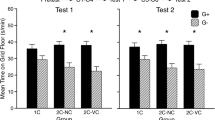Abstract
The effect of confinement during conditioning on subsequent test levels of locomotor activity and conditioned place preference (CPP) was investigated by giving rats discrimination training with morphine and saline in the presence of different tactile floor cues in an open field. Groups of rats were trained under one of three levels of confinement (not confined, confined to 1/4, or confined to 1/16 of the open field) and tested for locomotor activity and CPP in the entire open field after receiving a saline injection. Confined rats subsequently spent less time on the morphinepaired floor cues (CS+) and were more active throughout the open field during the test than rats not confined during conditioning. Rats confined to the smallest area spent the least time on the CS+ and were the most active. It is suggested that confinement may preserve the novelty of the testing environment, which in turn may interfere with rats' usual responses to incentive drug-paired stimuli. These findings may have important implications for versions of the CPP technique in which training and testing environments differ considerably.
Similar content being viewed by others
References
Bardo MT, Miller JS, Neisewander JL (1984) Conditioned place preference with morphine: The effect of extinction training on the reinforcing CR. Pharmacol Biochem Behav 21:545–549
Bindra D (1968) Neuropsychological interpretation of the effects of drive and incentive-motivation on general activity and instrumental behavior. Psychol Rev 75:1–22
Blander A, Hunt T, Blair R, Amit Z (1984) Conditioned place preference: An evaluation of morphine's positive reinforcing properties. Psychopharmacology 84:124–127
Bozarth MA (1987) Conditioned place preference: A parametric analysis using systemic heroin injections. In: Bozarth MA (ed) Methods of assessing the reinforcing properties of abused drugs. Springer, New York Berlin Heidelberg (in press)
Carr GD, Phillips AG, Hancock S, Fibiger HC (1986) Dopamine, reward and locomotion: Amphetamine place preference is not dependent on locomotion. Can J Psychol 27:97
Iversen SD (1983) Brain endorphins and reward function: Some thoughts and speculations. In: Smith JE, Lane JD (eds) The neurobiology of opiate reward processes. Elsevier/North Holland Biomedical, Amsterdam, pp 439–468
Kirk RE (1968) Experimental design: Procedures for the behavioral sciences. Brooks/Cole, Belmont
Mucha RF, Iversen SD (1984) Reinforcing properties of morphine and naloxone revealed by conditioned place preference: A procedural examination. Psychopharmacology 82:241–247
Schiff SR (1982) Conditioned dopaminergic activity. Biol Psychiatry 17:135–154
Stewart J, Eikelboom R (1987) Conditioned drug effects. In: Iversen LL, Iversen SD, Snyder SH (eds) Handbook of psychopharmacology, vol 19. Plenum, New York, pp 1–57
Stewart J, deWit H, Eikelboom R (1984) The role of unconditioned and conditioned drug effects in the self-administration of opiates and stimulants. Psychol Rev 91:251–268
Swerdlow NR, Koob GF (1984) Restrained rats learn amphetamine-conditioned locomotion, but not place preference. Psychopharmacology 84:163–166
Van der Kooy D (1987) Place conditioning: A simple and effective method for assessing the motivational properties of drugs. In: Bozarth MA (ed) Methods of assessing the reinforcing properties of abused drugs. Springer, New York Berlin Heidelberg (in press)
Vezina P, Stewart J (1984) Conditioning and place-specific sensitization of increases in activity induced by morphine in the VTA. Pharmacol Biochem Behav 20:925–934
Vezina P, Stewart J (1987) Conditioned locomotion and place preference elicited by tactile cues paired exclusively with morphine in an open field. Psychopharmacology 91:375–380
Zimbardo PG, Montgomery KC (1957) The relative strengths of consummatory responses in hunger, thirst, and exploration drive. J Comp Physiol Psychol 50:504–508
Author information
Authors and Affiliations
Rights and permissions
About this article
Cite this article
Vezina, P., Stewart, J. Morphine conditioned place preference and locomotion: the effect of confinement during training. Psychopharmacology 93, 257–260 (1987). https://doi.org/10.1007/BF00179944
Received:
Revised:
Issue Date:
DOI: https://doi.org/10.1007/BF00179944




